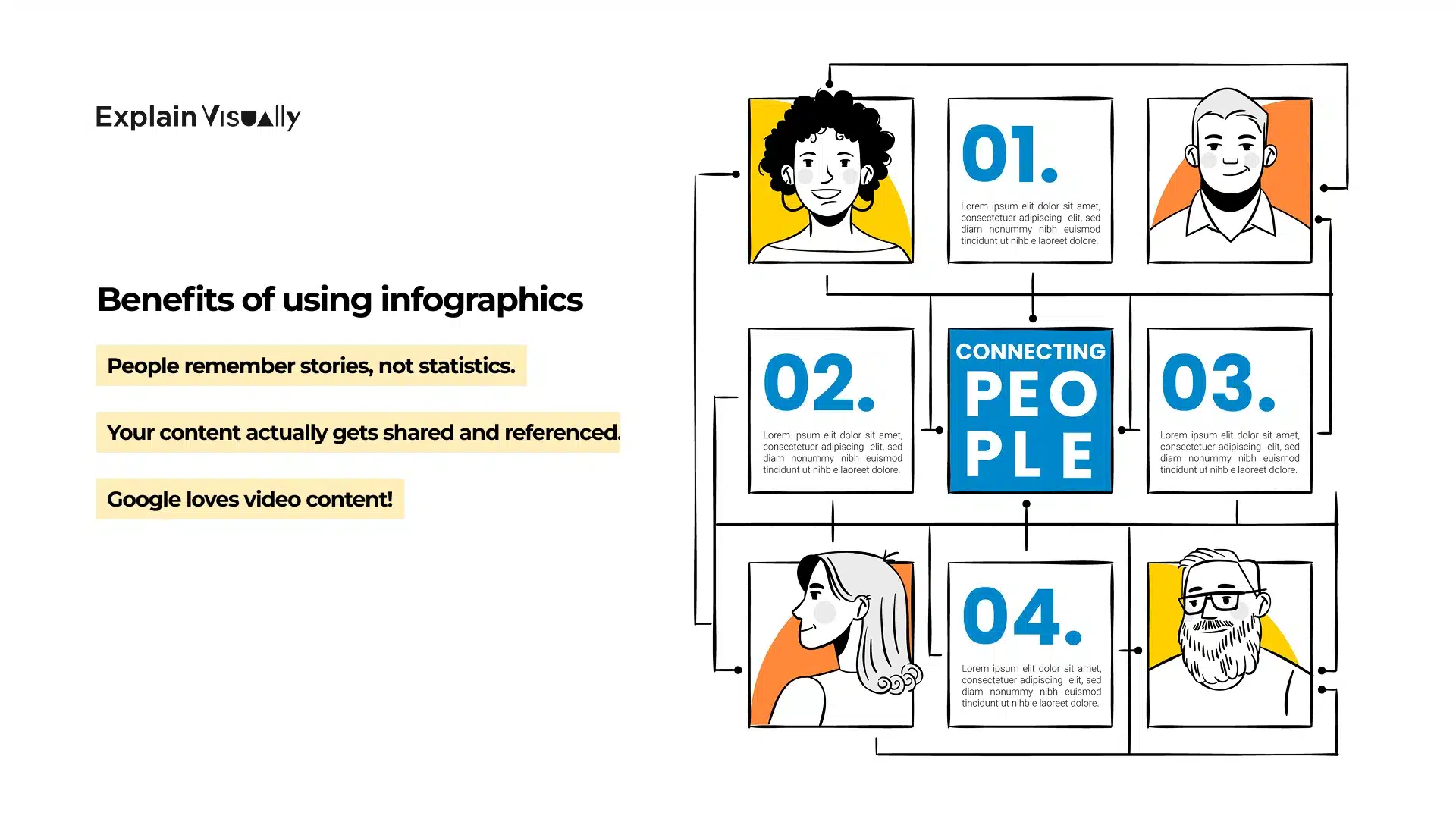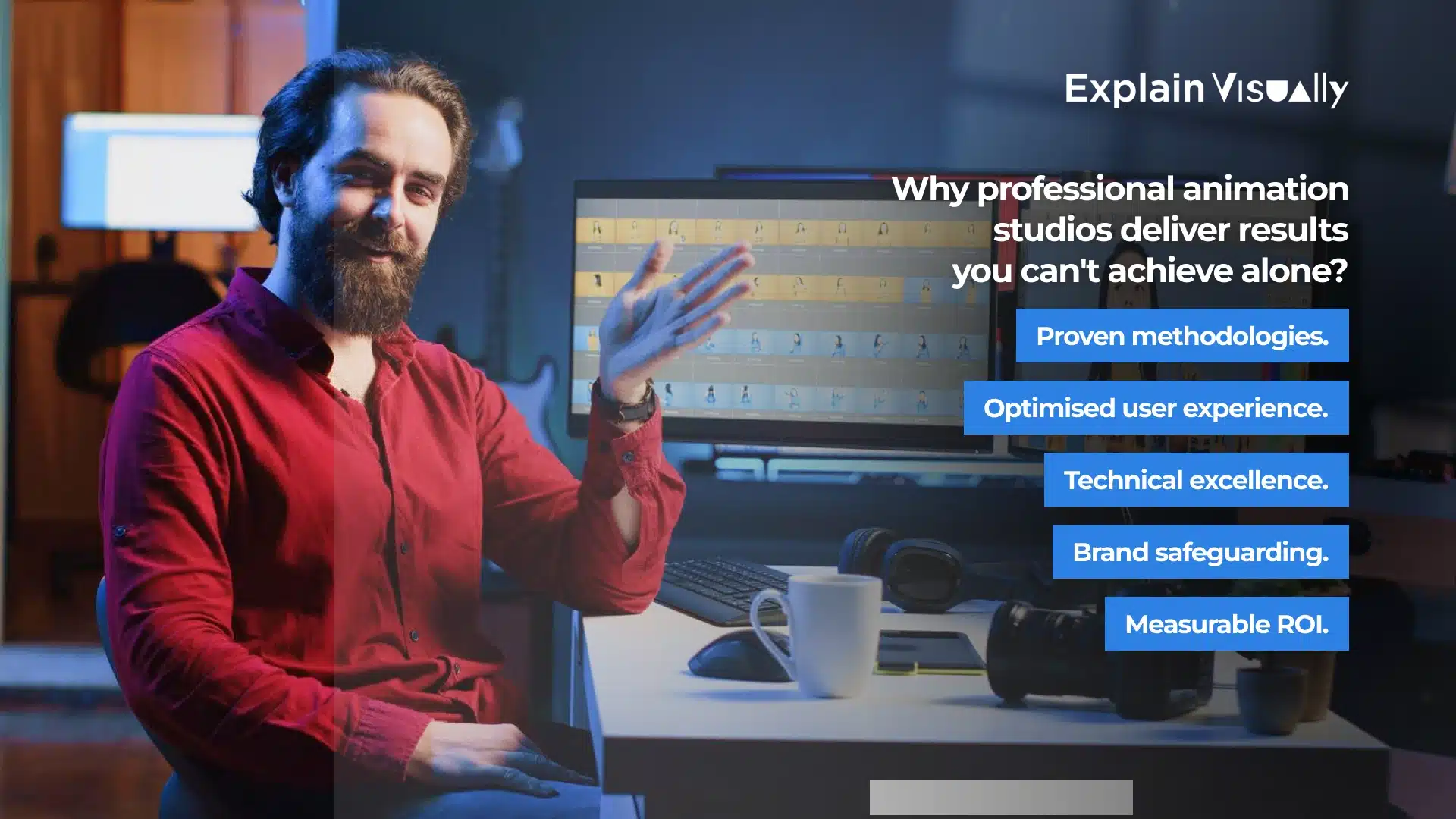Why do cat videos go viral, but critical insights get scrolled past? It’s not the content, it’s the format. Animated infographics make even the densest data scroll-stopping.
Your spreadsheets are good?
Your insights are spot-on?
But…
somehow, when you present them, people’s eyes glaze over within seconds. Most professionals struggle with the same frustrating reality that even the most valuable data gets ignored when it looks boring.
Here’s what changed everything for many businesses: animated infographics.
Not because they’re flashy or trendy, but because they work. They take your carefully researched findings and present them in ways that actually make people pay attention. Instead of scrolling past your charts, your audience stops, watches, and remembers your key message.
The difference lies in choosing tools that make things move and make complex information genuinely easier to understand. Let’s take a closer look at this.
Animated infographics – how they can transform your business?
Most people switch off when they see another PowerPoint slide packed with numbers, whether it’s during a board meeting, employee training session, or industry conference. Animated infographics change this completely:
- They walk your viewers through the story your data tells, one piece at a time.
- Instead of dumping everything on screen at once, they reveal insights gradually.
- They stop people feeling overwhelmed during presentations, workshops, or instructional sessions.

There’s actual science behind why this works so well in any presentation context:
Your brain grabs onto moving visuals much faster than it processes written text . We’re talking about a huge difference in speed here. When you add animation to your data, you’re helping people connect the dots between different pieces of information naturally.
The movement guides their eye from one insight to the next, creating those “Aha!” moments when everything clicks together. They stop seeing random numbers scattered across a page. They start understanding the bigger picture you’re trying to show them. Animation creates a narrative flow that static charts simply can’t match, whether you’re presenting to clients, training new employees, or delivering conference keynotes.
Animated infographics transform how you communicate across all business contexts
The business benefits go way beyond just looking more professional in meetings. Examples?
In conference presentations, they keep audience members engaged instead of checking their phones halfway through your talk. Conference speakers using them receive more positive feedback and networking opportunities.
During employee training sessions, complex procedures become easier to follow and remember.
Client presentations become more persuasive because your key message lands with greater impact.
Real example: When Infinity Insurance faced the challenge of explaining IT insurance – hardly the most exciting topic – they turned to animation. Instead of boring their audience with technical jargon, they created animated content that was both engaging and easy to follow, making complex insurance concepts genuinely accessible (polish version).
They also shine in digital contexts. Keeping people on your website longer because they’re genuinely interested in seeing what comes next in the story. They get shared more often on social media. Moving content catches attention in crowded feeds where everything else sits still. Your presentations become memorable instead of forgettable.
It’s not magic or luck!
Movement naturally catches human attention. Good pacing keeps people watching until they’ve absorbed your main points completely (regardless of the setting).
Why animated infographics work better than traditional presentations?
We’ve actually answered this question already, but we have a few more arguments (at least) for the sceptics 🤓.
There’s one undeniable fact: Most business presentations are boring.
You’ve probably sat through countless meetings, conferences, or training sessions where someone clicked through slide after slide of bullet points and charts, and you struggled to stay awake.
Visual storytelling through infographics changes this completely, whether you’re presenting to a boardroom of executives, training new employees, or speaking at an industry conference. Instead of forcing people to decode complex spreadsheets, you give them a story they can actually follow and understand, regardless of their expertise level or the setting.

People remember stories, not statistics
When you show someone a list of numbers during a presentation or training session, they’ll forget most of it within an hour. But wrap those same numbers in a visual story, and suddenly they stick for weeks or… even months.
Enhanced comprehension happens because your brain processes images differently than text. When you combine clear visuals with straightforward explanations, people don’t just see your data – and this is the crucial part – they actually get it!
This makes a huge difference particularly when:
- you’re trying to explain complicated processes to colleagues who aren’t experts in your field,
- onboarding new team members,
- presenting complex proposals to clients who need to understand your recommendations quickly.
Example: Pepsico. “A whiteboard-style animation presenting the health and safety regulations in force at the factory. New hires grasp procedures faster, seasoned employees remember policy updates longer, and everyone performs better because the information actually sticks (polish version).
Your content actually gets shared and referenced
- Online
Traditional reports sit in email inboxes and gather digital dust, while printed training materials end up forgotten in desk drawers. Animated infographics get passed around both digitally and through word-of-mouth. People share them on social media, forward them to colleagues, and reference them in conversations long after your presentation ends.
Each time someone shares your content, you’re reaching new people without spending extra money on advertising.It’s like word-of-mouth marketing, but faster and more effective.
- Offline
What happens when you show really good animated infographics during live presentations? People can’t help themselves. They start taking photos of your slides, and then something even better happens. They approach you afterward asking if they can share your infographics with their teams.
“Can I get a copy of that animation?”
– becomes the most common question you hear during networking breaks. Not because they’re being pushy (or brown-nosing😅), but because they genuinely want to remember and share what you’ve shown them.
Multiple business applications drive real ROI
The versatility of infographics means they deliver value across every aspect of your business operations.
In sales contexts, they help prospects understand complex products or services faster. This leads to shorter sales cycles and higher conversion rates.
During employee training, they reduce the time needed to bring new hires up to speed. At the same time, they improve comprehension and retention.
At conferences and industry events, they make your presentations more memorable. This generates more networking opportunities and potential partnerships.
Google loves video content!
Search engines give them priority over static pages, which means your animated infographics show up higher in search results.
The principle is simple:
Greater visibility = more people find your website.
More visitors = more potential customers.
By creating better presentations, you’re improving your online presence. This SEO advantage deepens over time and most importantly – it continuously generates valuable traffic to your business without ongoing advertising costs.
That’s not all! Animated infographics:
- increase dwell time on your website,
- reduce bounce rates,
- improve user engagement metrics that search engines use to determine content quality.
Types of animated infographics
You need to know one thing: not all animated infographics are created equal. Sounds obvious, right? But trust us, it’s not obvious to everyone. In reality, you have huge variety and plenty of room to manoeuvre – especially if you decide to work with a professional animation studio that, let’s be honest, will simply do the job best for you.

Whiteboard animation feels like having a personal tutor
Whiteboard animation taps into this natural learning preference by creating the feeling that someone’s explaining ideas directly to you, sketch by sketch. This style works brilliantly for educational content, step-by-step processes, and breaking down complicated concepts that might otherwise overwhelm people.
Example: Whiteboard animation about health and safety rules in Greenyard.
Digital whiteboard brings polish without losing personality
Digital whiteboard animation takes everything that works about traditional whiteboard style and adds professional polish. You get:
–cleaner lines,
– strategic use of colour,
– smoother transitions.
The style maintains that personal, educational feel while meeting the visual standards your audience expects in professional contexts.
Example: National Tax Information.The animation explains in a simple way what the Eureka system is and what its advantages are (Polish version).
Vector animation delivers crisp results everywhere
When you need your animated infographics to look sharp on everything (from smartphone screens to conference hall projectors), choose vector animation.
This style creates clean, scalable visuals that maintain their quality regardless of where people view them. Vector animation works particularly well for data presentation because it can handle complex charts and graphs without losing clarity.
Example: Vector animation for RAW Cyber. How to protect your phone from cyberattacks?
Motion graphics make information dynamic
Instead of showing a boring bullet point list, you can have text elements appear, highlight, and transition in ways that guide attention exactly where you want it.
This approach works exceptionally well for:
– presenting statistics,
– emphasizing key findings,
– creating eye catching visuals that perform well on social media.
The movement isn’t just decorative – it actively helps viewers process and remember your most important points.
Character-based animation creates emotional connections
Sometimes your complex information needs a human touch to really connect with viewers (for example interactive elements with real life examples). Character-based animation uses illustrated figures to guide people through your content.
This style proves especially valuable when you’re explaining processes that involve human behavior, customer journeys, or situations where your audience needs to see themselves in the scenario you’re describing.
Social Media and video infographics
Let’s revisit social media briefly, and we’re not only thinking about Instagram or Facebook here, but also those other channels that have real impact on today’s business success – platforms like YouTube and LinkedIn…
Infographic videos perform exceptionally well across social media because they capture attention quickly in crowded feeds. The combination of movement and information satisfies platforms’ algorithms that favour engaging content whilst providing value that encourages sharing.
And pay attention! Platform specifications matter significantly.
- Instagram favours square formats.
- LinkedIn responds well to professional, data-heavy content.
- TikTok and Instagram Reels require vertical orientations and shorter attention spans.
Design your animated infographics with specific platform requirements in mind for maximum impact.
What else should you consider?
Timing your posts affects reach and engagement substantially.
Animated infographics containing statistics or trends work well during business hours when professionals are active, whilst entertainment-focused content might perform better during evening leisure hours.
Hashtag strategies help your content reach relevant audiences beyond your immediate followers.
Research platform-specific hashtags related to your industry, content type, and target audience to maximise discoverability.
Creating interactive infographics with expert help
You focus on your business – specialists focus on strengthening your brand’s prestige, building trust, and making you unforgettable!
When prospects see your expertly crafted animated infographics, they immediately understand they’re dealing with a company that takes quality seriously and invests in excellence.
Why professional animation studios deliver results you can’t achieve alone?
Some people believe that goodwill and software (pirated😄) are all you need. Oh, how wrong they are…

Professional animation studios bring years of experience in understanding what actually works in real business contexts. They know how to:
structure information flow to maximise comprehension;
choose colour schemes that enhance readability across different devices;
time animations to match natural cognitive processing speeds.
When you work with experts, you’re not just getting prettier visuals – you’re accessing proven methodologies that transform complex data into compelling narratives that drive action.
Professional studios also understand the technical requirements that separate amateur attempts from polished results. They:
ensure your animated infographics load quickly on all devices,
maintain visual quality across different screen sizes,
integrate seamlessly with your existing marketing materials.
The difference shows immediately when prospects view your content.
Expertise that protects your brand reputation
Working with animation specialists means avoiding the costly mistakes that can damage your brand’s professional image. They understand industry best practices for data visualization, ensuring your information remains accurate while becoming more engaging.
The investment in professional expertise pays for itself through improved business outcomes
Let’s face it: When your animated infographics look polished and function flawlessly, prospects take your business more seriously. Clients remember your presentations longer. Conference attendees seek you out for follow-up conversations. Your content gets shared more frequently because people feel confident associating their professional reputation with your high-quality materials.
Visual storytelling with best infographics – Explain Visually’s professional animation services
We don’t need to talk much about our strengths and skills. We don’t persuade or convince with words – we show and prove to future clients why it’s worth it. How do we do that? Everything is on display in our portfolio.
Our production process ensures every project meets professional standards whilst reflecting your unique requirements.
We begin with collaborative workshops where we understand your objectives, audience, and key message. This foundation phase prevents miscommunication whilst ensuring our creative approach aligns with your goals.
Script development follows, where we craft narratives that balance information density with engagement. Our writers understand how to structure content for animated delivery, ensuring viewers can absorb information effectively without feeling overwhelmed.
Storyboard creation visualises your content before animation begins. This planning stage allows you to review pacing, visual choices, and information flow, making adjustments efficiently before moving to production phases.
Animation production brings your content to life through our skilled team’s technical expertise. We maintain regular communication throughout this phase, providing updates and incorporating your feedback to ensure final results exceed expectations.
Our feedback process includes multiple review stages where you can request adjustments and refinements.
The final delivery includes optimised versions for different platforms and usage contexts (files for social media, website embedding, or presentation use).
𝐄𝐱𝐩𝐥𝐚𝐢𝐧 𝐕𝐢𝐬𝐮𝐚𝐥𝐥𝐲 – 𝐁𝟐𝐁 𝐚𝐧𝐢𝐦𝐚𝐭𝐢𝐨𝐧 𝐬𝐭𝐮𝐝𝐢𝐨:
• We create whiteboard animations for businesses
• We create corporate explainer videos
• We create visual storytelling for companies


